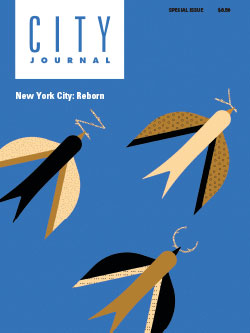On March 1, 2020, the first case of Covid-19 was reported in the New York City metropolitan region; soon after, the city was the epicenter of the pandemic. By the third week of March, Governor Andrew Cuomo had implemented policies aimed at stopping the spread. Businesses and schools were closed, and residents had to “shelter in place.” The initial reactions in New York were blame and fear. Blame: the city was responsible for the spreading of the virus; its density—long hailed as a boon for humanity—was now the source of its ruin. Fear: all that we cherished would be lost.
But the success or failure of big cities depends on how well they balance two opposing forces. All cities exist somewhere between the centripetal forces that pull us together and the centrifugal forces that push us apart. It’s in the interstices, one might say, between the costs and benefits of urban living that our cities operate. When the centrifugal forces are relatively strong, the city begins to decline; when the opposite is true, the city grows.
Among the centripetal forces are those that we cherish about urban living: cities are hubs for jobs, new ideas, and cultural and social vitality. The urban center holds because businesses cluster—they learn from one another, share resources, reduce their costs, and become more competitive. Firms with national or international ambitions find themselves gravitating to big cities, if only for the status it brings.
While smaller cities may have charm and some unique offerings, larger, global cities can do things that smaller ones cannot, such as attracting the finest talent and providing a more diverse array of services. In this way, large cities are a kind of self-perpetuating machine: jobs fuel income, income fuels spending, spending fuels jobs, and so on. This is the fundamental logic of why large cities endure.
If cities were all gain and no pain, each nation would need only one place for nearly its entire population. But this is not the case—centrifugal forces check urban growth. The Covid-19 outbreak is an obvious example. More broadly, the hurly-burly of urban life—from factors including pollution, congestion, crime, and expensive and cramped housing—takes a toll. These forces push some people out and stop others from moving in. Then there’s city competition. At any one time, some cities are looking for workers at a faster rate than others, and people are drawn to them as a result. Technological and historical changes can also render certain cities’ strengths obsolete; rising cities, with new advantages, take their place.
Amid the current crisis, if we take a step back and look at the positive and negative forces that have come to operate in New York, the city’s history offers encouragement.
New York City in 2019, for example, was a very different place from what it had been over half a century ago, when it began hemorrhaging jobs. Between 1960 and 1980, New York lost nearly half a million manufacturing positions; during the 1970s, its population shrank by 10 percent. New York seemed to be on a similar path as Detroit and other manufacturing cities. But after a generation of restructuring, New York saw a renaissance. It reinvented itself as a global services city, ideally suited to meet the needs of a high-tech, knowledge-based twenty-first-century world.
The forces that made New York so successful have never really gone away. New York’s centrality in the global network of cities has deepened as the world has become more interconnected. For a few decades, the negative centrifugal forces were giving the city serious trouble, and it would have taken a true visionary to see a bright future in 1975, but the positive seeds were there; they were just obscured from view.
To be sure, many people who have adapted to working at home during the pandemic will continue to do so, perhaps for the rest of their working lives. But those starting college this summer will likely think little of social distancing at work when they begin their careers in four or five years—just as today’s millennials know little about the crime that plagued the city before the 1990s. Those residents whom the crisis chases off will be replaced by those seeking opportunities when the crisis has passed.
The centrifugal forces that pushed people out before the pandemic were primarily based on the city’s unwillingness to grow its housing stock, improve its mass transit, and upgrade its infrastructure to accommodate economic growth, resulting in expensive housing and a congested transportation system. Until the Covid-19 epidemic is fully gone, New York, with a somewhat shrunken population, will have excess capacity. The city should take this opportunity to plan for its next growth spurt—it will be here before we know it.
Photo by Spencer Platt/Getty Images






